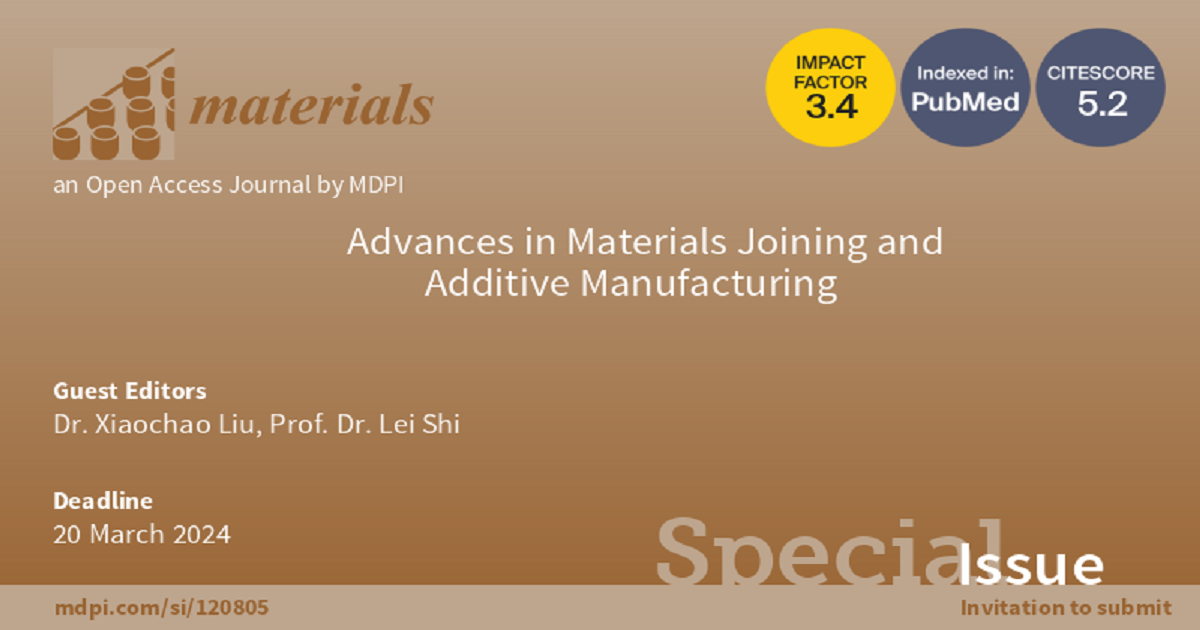Advances in Materials Joining and Additive Manufacturing
A special issue of Materials (ISSN 1996-1944). This special issue belongs to the section "Manufacturing Processes and Systems".
Deadline for manuscript submissions: closed (20 March 2024) | Viewed by 41782

Special Issue Editors
Interests: welding; joining; additive manufacturing; modelling; friction stir welding; friction stir additive manufacturing
Special Issues, Collections and Topics in MDPI journals
Interests: numerical simulation; friction stir welding; phase field simulation; additive manufacturing; welding and joining
Special Issues, Collections and Topics in MDPI journals
Special Issue Information
Dear Colleagues,
With the increasingly potent energy problem, modern manufacturing industry pays increasing amounts of attention to energy conservation and emission reduction. As widely used manufacturing processes, material joining and additive manufacturing could play an important role in energy saving and emission reduction. Therefore, continually developing new material joining and additive manufacturing techniques to improve the manufacturing efficiency and quality, as well as to save energy, is an eternal pursuit for researchers. Recently, many advances in material joining and additive manufacturing have been made by our colleagues. Summarizing these new techniques and new mechanisms is very necessary to further promote energy conservation and emission reduction in the manufacturing industry.
The main purpose of this Special Issue on “Advances in Materials Joining and Additive Manufacturing” is to collect the advances in material joining and additive manufacturing aspects. The main content of this Special Issue includes, but is not limited to, arc welding, high energy beam welding, brazing, diffusion welding, friction welding, friction stir welding, wire arc additive manufacturing, friction stir additive manufacturing, cold spraying additive manufacturing, and their modelling techniques.
Dr. Xiaochao Liu
Prof. Dr. Lei Shi
Guest Editors
Manuscript Submission Information
Manuscripts should be submitted online at www.mdpi.com by registering and logging in to this website. Once you are registered, click here to go to the submission form. Manuscripts can be submitted until the deadline. All submissions that pass pre-check are peer-reviewed. Accepted papers will be published continuously in the journal (as soon as accepted) and will be listed together on the special issue website. Research articles, review articles as well as short communications are invited. For planned papers, a title and short abstract (about 100 words) can be sent to the Editorial Office for announcement on this website.
Submitted manuscripts should not have been published previously, nor be under consideration for publication elsewhere (except conference proceedings papers). All manuscripts are thoroughly refereed through a single-blind peer-review process. A guide for authors and other relevant information for submission of manuscripts is available on the Instructions for Authors page. Materials is an international peer-reviewed open access semimonthly journal published by MDPI.
Please visit the Instructions for Authors page before submitting a manuscript. The Article Processing Charge (APC) for publication in this open access journal is 2600 CHF (Swiss Francs). Submitted papers should be well formatted and use good English. Authors may use MDPI's English editing service prior to publication or during author revisions.
Keywords
- fusion welding
- solid-state welding
- fusion-based additive manufacturing
- solid-state additive manufacturing
- numerical simulation
Benefits of Publishing in a Special Issue
- Ease of navigation: Grouping papers by topic helps scholars navigate broad scope journals more efficiently.
- Greater discoverability: Special Issues support the reach and impact of scientific research. Articles in Special Issues are more discoverable and cited more frequently.
- Expansion of research network: Special Issues facilitate connections among authors, fostering scientific collaborations.
- External promotion: Articles in Special Issues are often promoted through the journal's social media, increasing their visibility.
- e-Book format: Special Issues with more than 10 articles can be published as dedicated e-books, ensuring wide and rapid dissemination.
Further information on MDPI's Special Issue polices can be found here.







